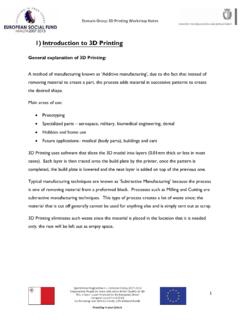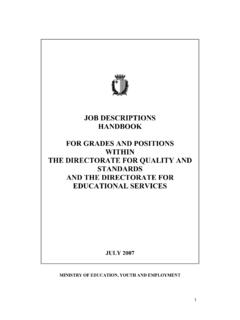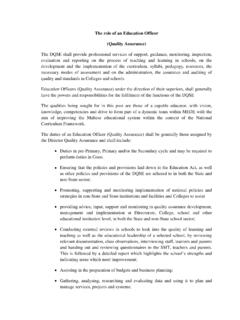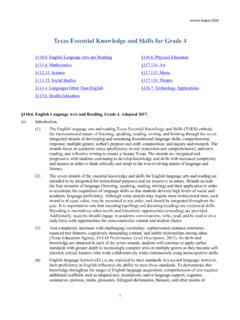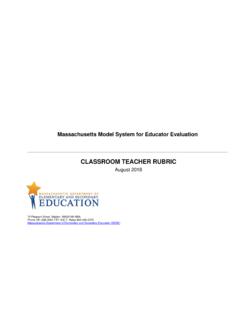Transcription of Digital Literacy - Education
1 Digital Literacy21st Century Competences for Our AgeThe Building Blocks of Digital LiteracyFrom Enhancement to TransformationApril 2015 Department of eLearning2 TABLE OF CONTENTSP urpose 4 Objective 4 Towards Transformation 6 Digital Literacy 7 Definitions 7 European Commission 8 Digital Literacy and Citizenship 12 Technology in the classroom 12 The cognitive and the infrastructure 12 Reflecting on the foundation blocks 12 Competence and Process 15 Conclusion 16 References 173 Learners are entitled to be digitally literate. 4 PurposeThe purpose of this document is to raise awareness of the importance of Digital Literacy within the Education framework in Malta and a chance to reflect and introspect on the teaching and learning process. ObjectiveThe objective of the eLearning Department (eLD) within the Directorate for Quality and Standards in Education (DQSE) in the Ministry for Education and Employment (MEDE) is to help educators make the shift from traditional teaching and a traditional pedagogical approach to a 21st century learning environment.
2 Our objective is to support and guide each teacher to make that shift. This setting is embedded in an interconnected and technology-driven world which has widened the learning place to the virtual, online, remote and anytime conditions. The eLearning Department is committed to progressively show what this environment looks like and how schools can teach 21st century skills as eLearning Department in collaboration with the Curriculum Department within DQSE aims to shape the pedagogy since we touch literacies which have mainly been brought about through the Digital environment. If a simple, starting definition of Digital Literacy had to be inserted at this point it would be: Digital Literacy is Literacy via technology. However things are not that simple.
3 Literacy is not only the ability to read and write, but rather the ability to put these skills to work in shaping the course of one s own life. The educator Paulo Freire says that Literacy is reading the word and the world. 1 This adds to the complexity since technology is continuously changing the environment we live eLearning Department believes that changing the way we teach and understanding how we learn in a technology driven world requires a different mind set, in and beyond the classroom. Thus the first step is to help all educators to accept that there is a need for change because the world has changed drastically and is continuously changing at an alarming rate. The second step is to continue to help educators understand that technology can help them achieve easily the heights that are unreachable without Digital tools.
4 In practical terms this boils down to tackling Literacy beyond the 3Rs and as educators start encompassing the 6Cs of 21st 1 competences: collaboration, communication, critical thinking, creativity, citizenship and character Digital Literacy document is written for all levels from Kindergarten to Year 12 teachers and Education leaders. The 21st century competences are skills, knowledge and attitudes that citizens needs in life beyond school, in their lifelong learning journey. As we make our way into the second decade of the 21st century, our society is increasingly becoming a Digital culture. Learners who are born into this culture are entitled to understand and profit from this environment which is new to us born in the 20th century.
5 They are entitled to be digitally literate. Digital Competence is both a requirement and a right of citizens, if they are to be functional in today s society. (Ferrari, 2012)This entitlement or right puts upon educators the responsibility to nurture and develop a number of competences in students so that they can take part in the social, cultural, economic and intellectual life. Thus becoming active citizens. In this environment, the teacher s role becomes challenging and increasingly more important. Every educator must understand that Digital Literacy is essential if we want our citizens to participate in today s modern world. Mark Surman, Executive Director of the Mozilla Foundation, in an interview for the November 2013 editorial in The Telegraph said that Digital Literacy is as important as reading , writing, arithmetic and other traditional disciplines.
6 Becoming literate in how the technical world works is equivalent to reading , writing and maths. We need to look at this fourth Literacy as mainstream. 2We know that the technical world is a different place than it was ten years ago. In 2007 the first smart phone was introduced and a new career of app developer was born. How did these first developers get there when there was no prescribed path for them to take? We can list numerous new careers that did not exist ten years ago. A key ingredient in these new jobs is that they require people who are digitally literate. In developed countries, 4 out of the 7 fastest growing jobs directly require technology skills (2 of them being in software development) Digital Competence is both a requirement and a right of citizens, if they are to be functional in today s society.
7 (Ferrari, 2012) 6 Towards TransformationIn 2001, Marc Prensky coined the terms Digital natives and Digital migrants to describe the behavioural differences between Baby Boomers and Generation Z4. Prensky argues that those who have grown with ubiquitous access to Digital technology think differently to previous generations whose introduction to technology came later on in life. Although the terms have been challenged by many academics, there is much resonance in Prensky s assertion that teaching young people represents a significant challenge for educators, associating Digital natives with: speed, multi-tasking, and a preference for graphics over text, random access, social networking, instant gratification, frequent rewards, and games over s generation appears to engage with all things that are Digital without any effort at all.
8 Young people are born into an interactive, on demand Digital culture where they are used to texting, video streaming, mobile Internet and social networking to mention just a few. However, this description, which may have implanted itself in some of us, is a dead metaphor because it veils and conceals a potential problem. While it is true that most of our young people do not need to be persuaded to use technology, and the time they spend glued to what they love doing most quickly improves their skills, research indicates that learners do not really know how to capitalise on technology (Poore, 2011; Mueller et al., personalfinance/2013/12/08/7-fastest-gro wing-jobs-in-america/3891571/ (Horizon 2020) 4 Baby boomers describes the cohort of babies born from the end of WWII all the way up to the early 1960s while Gen Z are the group born since just before the start of the ; Boyd, 2014).
9 Learners need to acquire Digital Literacy skills, as without any form of formal guidance, they are likely to remain uninformed and uncritical users of ICT. A couple of visits to is enough to raise concerns about a generation that is not fully digitally literate, yet deeply immersed in Kapor has remarked that, Getting information off the Internet is like taking a drink from a fire hydrant . With the Internet approaching 1 trillion pages, that statement has never been truer. Every day, every minute, more information is added to the Internet, with no sign of slowing down. Being digitally literate means being able to sift through so much information, being able to understand a message and to communicate it effectively to others in different formats.
10 It means creating, collaborating, communicating, working ethically and understanding when, if and how technology should be used to reach efficiently an objective. So Digital Literacy involves the critical use of technology. It involves the awareness of and critical analysis of agendas and possible dangers with which technology invades our daily lives. It involves educating students to move from a passive consumer of information to an active producer both as individuals and as part of a community. If our young generation - indeed all citizens - lack Digital competences, they risk being disenfranchised when it comes to employment opportunities, democratic participation and social our students to manage challenges in today s modern world and whatever the future will bring is a core objective of the National Curriculum Framework.

